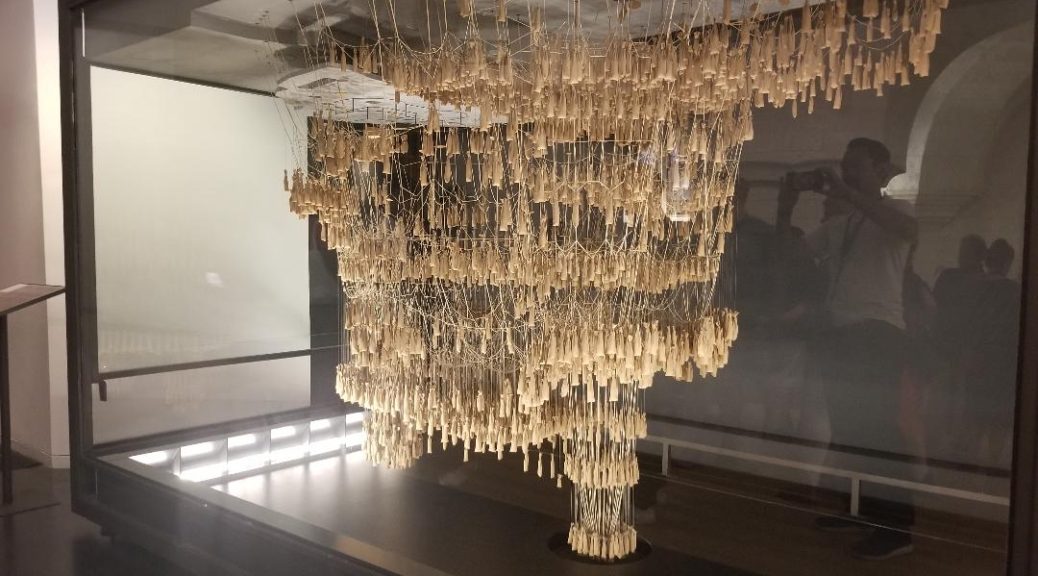
Teach Arts to Solve Problems
“Originality consists in returning to the origin.”
– Antoni Gaudí
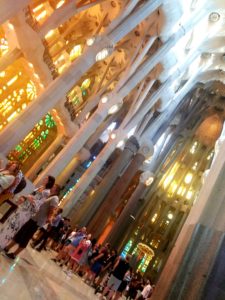 During my trip to Spain this year, I departed from my typical path through Andalucía, for a jaunt to the north, in an exploration of art, history, and nature that brought unexpected delights. I returned to the Basílica de la Sagrada Familia, the iconic architectural feat by Antoni Gaudí, located in Barcelona. I last visited this Catholic church in 2003, when we were permitted to see the future site of the sanctuary from a temporary boardwalk, inside the building. The church was filled with bulldozers, hard hats, and dust back then. In 2019, the sanctuary was filled with crowds of people, visiting to see the now completed sanctuary: its shiny floor tiles, stained glass windows, a pipe organ, and all of the marvels that one would expect. Upon my return to the famous basilica, I found that the building that had once seemed to me to be a senseless example of extravagance, transformed to a pinnacle of creativity in science. I realized the many ways the design and construction of the church reflected the values that we teach in flamenco classes.
During my trip to Spain this year, I departed from my typical path through Andalucía, for a jaunt to the north, in an exploration of art, history, and nature that brought unexpected delights. I returned to the Basílica de la Sagrada Familia, the iconic architectural feat by Antoni Gaudí, located in Barcelona. I last visited this Catholic church in 2003, when we were permitted to see the future site of the sanctuary from a temporary boardwalk, inside the building. The church was filled with bulldozers, hard hats, and dust back then. In 2019, the sanctuary was filled with crowds of people, visiting to see the now completed sanctuary: its shiny floor tiles, stained glass windows, a pipe organ, and all of the marvels that one would expect. Upon my return to the famous basilica, I found that the building that had once seemed to me to be a senseless example of extravagance, transformed to a pinnacle of creativity in science. I realized the many ways the design and construction of the church reflected the values that we teach in flamenco classes.
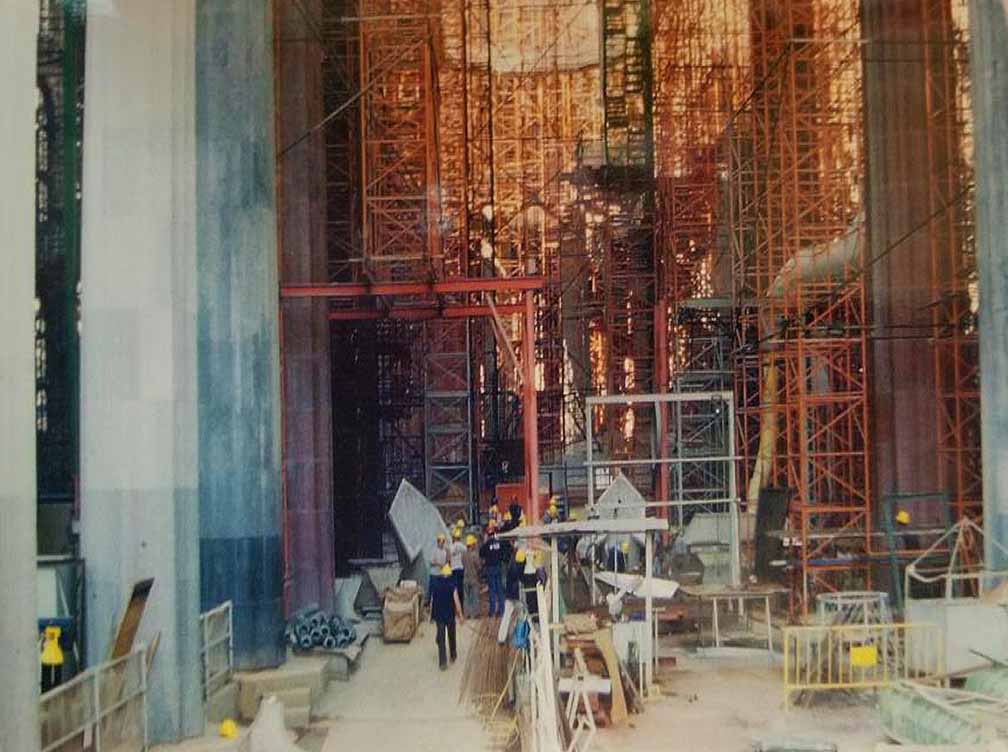 La Sagrada de la Familia, 2003.
La Sagrada de la Familia, 2003.
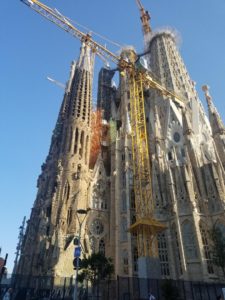 The organic look of the Sagrada Familia contradicts the aesthetic that most have come to expect in modern construction, including squared angles, straight lines, predictable curves. Gaudí set aside these geometric standards for a design based on his observation of trees. His conclusions about strength and weight load in nature, brought the artist to prefer the shape of the hyperbola over squares. His method echoes the connection between math, nature, art, and religion, that was created by ancient philosophers, who were trying to articulate the difference between the natural world observed and that imagined; the whole and its parts; man and thought. Their attempts to reconcile these matters led to some of the theories that are pillars of mathematics and art – architecture – today. Creativity traveled full circle in this masterpiece of Gaudí, who refused to accept existing dogma and instead reconciled original observation with imagination in a mix that remains in the realm of innovation.
The organic look of the Sagrada Familia contradicts the aesthetic that most have come to expect in modern construction, including squared angles, straight lines, predictable curves. Gaudí set aside these geometric standards for a design based on his observation of trees. His conclusions about strength and weight load in nature, brought the artist to prefer the shape of the hyperbola over squares. His method echoes the connection between math, nature, art, and religion, that was created by ancient philosophers, who were trying to articulate the difference between the natural world observed and that imagined; the whole and its parts; man and thought. Their attempts to reconcile these matters led to some of the theories that are pillars of mathematics and art – architecture – today. Creativity traveled full circle in this masterpiece of Gaudí, who refused to accept existing dogma and instead reconciled original observation with imagination in a mix that remains in the realm of innovation.
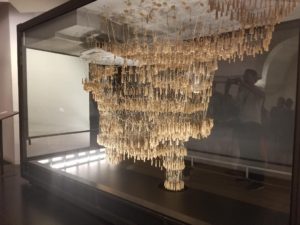
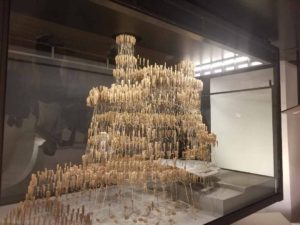
Photographed above: a scaled copy of the 3-D model that Gaudí created to articulate the catenary arches of the Sagrada Familia.
In addition to the hyperbolic arch, Gaudí used the catenary arch in his design, and he spent a decade creating a tangible model constructed of hundreds of these arches. His model was used to build the church, and later – over 100 years later – became the inspiration of modern design. The catenary arch is the curve created when a rope or chain bends under the weight of itself when suspended from two points. These u-shaped curves are inverted to make arches of the Sagrada Familia. Gaudí informed builders of the design of these arches by hanging weights from strings to form the shape of the temple. He photographed the creation, and then turned the photograph upside-down in order to create plans for the church. His approach to problem solving has since been studied in emerging technologies, including a workshop at MIT. Such upside-down thinking and perseverance are two values that artists often exhibit, as they meticulously investigate a subject from differing perspectives before crafting a public expression. It is not so different from the kind of study that scientists put toward solving problems.
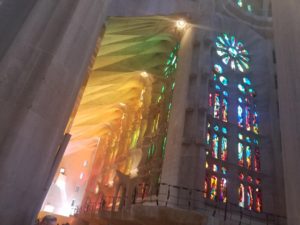 The Sagrada Familia is a majestic work of technology that is often misunderstood, because its outward appearance does not fit the organizational standards that many have come to expect in our modern world. It is the same with the often undervalued importance of creativity in education. A closer look at the influences that led to a seemingly haphazard placement of colors and cavities in the Sagrada Familia, reveals that there was genius at play decades before its time, because an innovative artist considered a variety of approaches to problem solving. Just as in the age of Gaudí, the arts today encourage minds to step out of accepted structures to discover – or rediscover – perspectives that will power change for the future, and these perspectives often do not fit the structure of standardized teaching and learning. Artists regularly undergo the process of observation and study that reveal facts from a variety of perspectives, in that timeless circle of curiosity and creativity. This lesson that the arts impart is the value of teaching kids to sing, to dance, to communicate in a new language.
The Sagrada Familia is a majestic work of technology that is often misunderstood, because its outward appearance does not fit the organizational standards that many have come to expect in our modern world. It is the same with the often undervalued importance of creativity in education. A closer look at the influences that led to a seemingly haphazard placement of colors and cavities in the Sagrada Familia, reveals that there was genius at play decades before its time, because an innovative artist considered a variety of approaches to problem solving. Just as in the age of Gaudí, the arts today encourage minds to step out of accepted structures to discover – or rediscover – perspectives that will power change for the future, and these perspectives often do not fit the structure of standardized teaching and learning. Artists regularly undergo the process of observation and study that reveal facts from a variety of perspectives, in that timeless circle of curiosity and creativity. This lesson that the arts impart is the value of teaching kids to sing, to dance, to communicate in a new language.